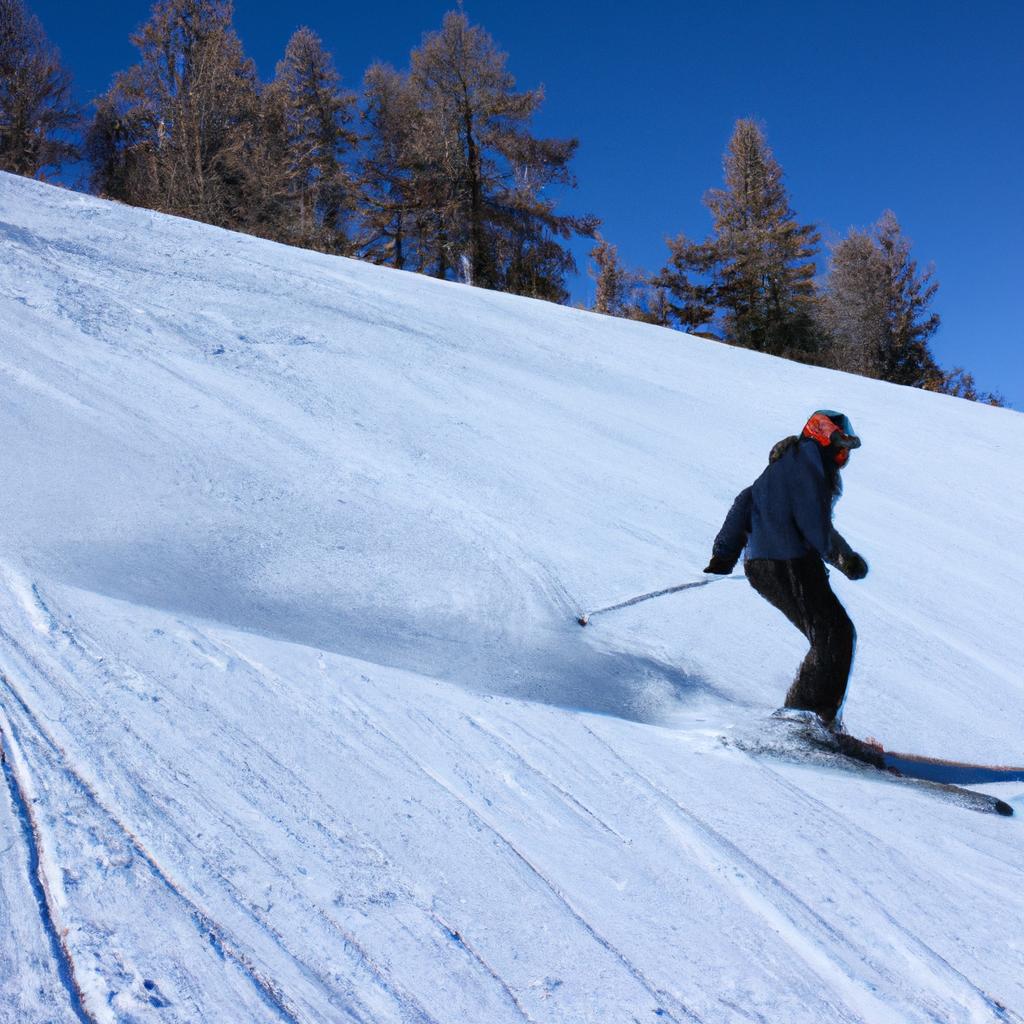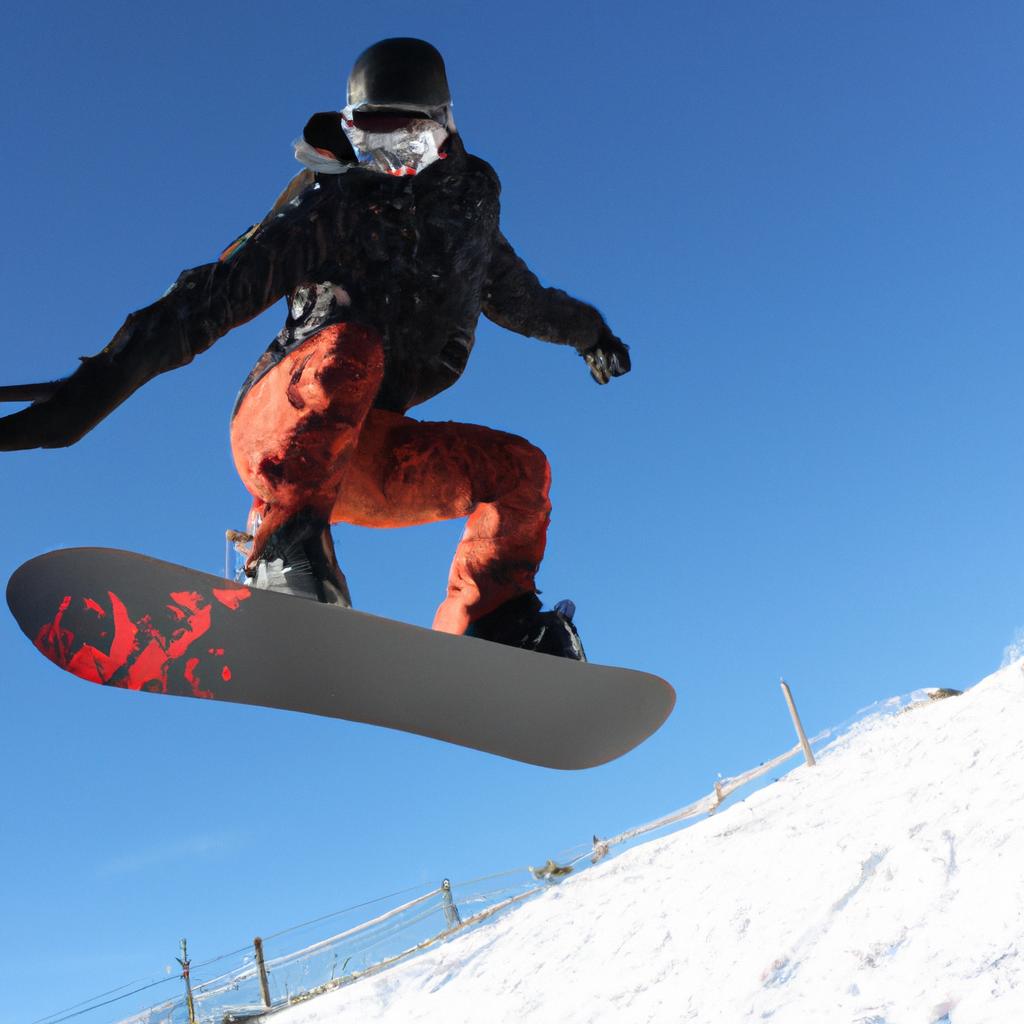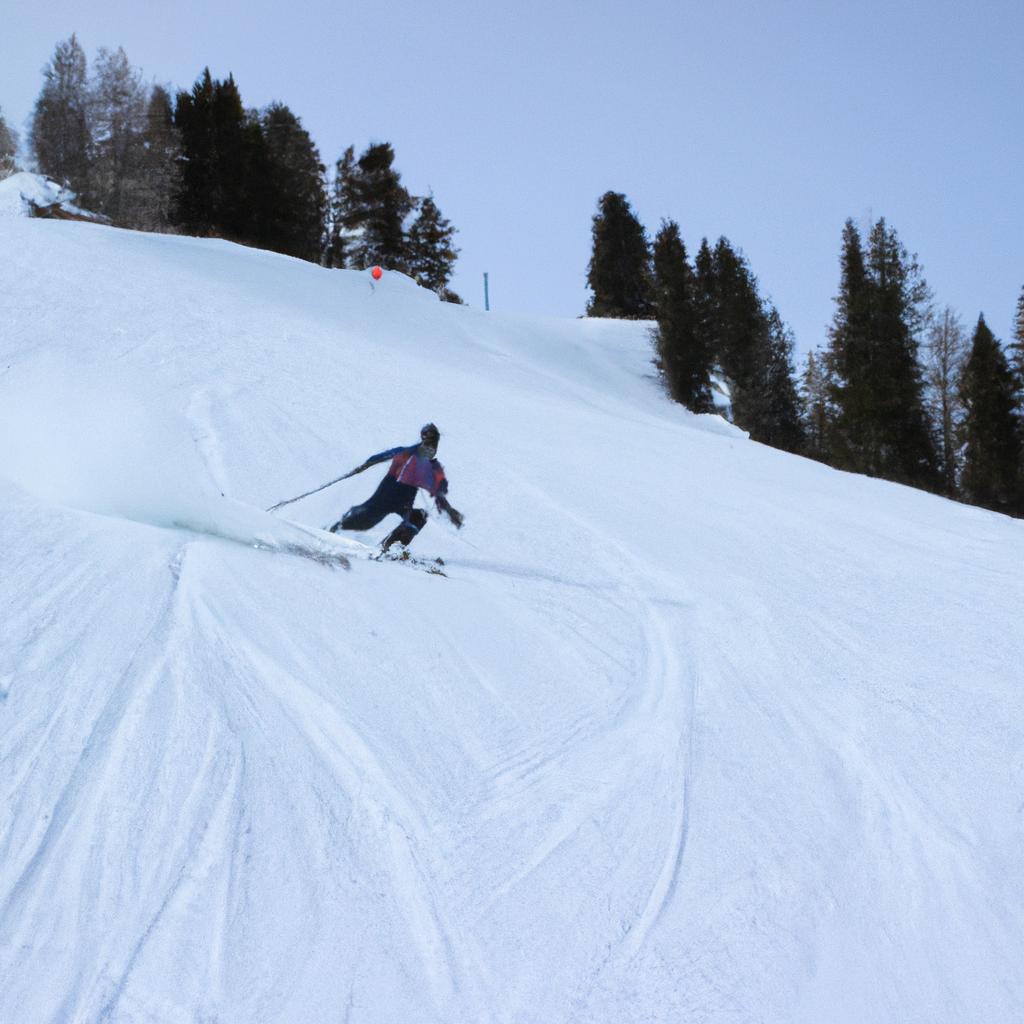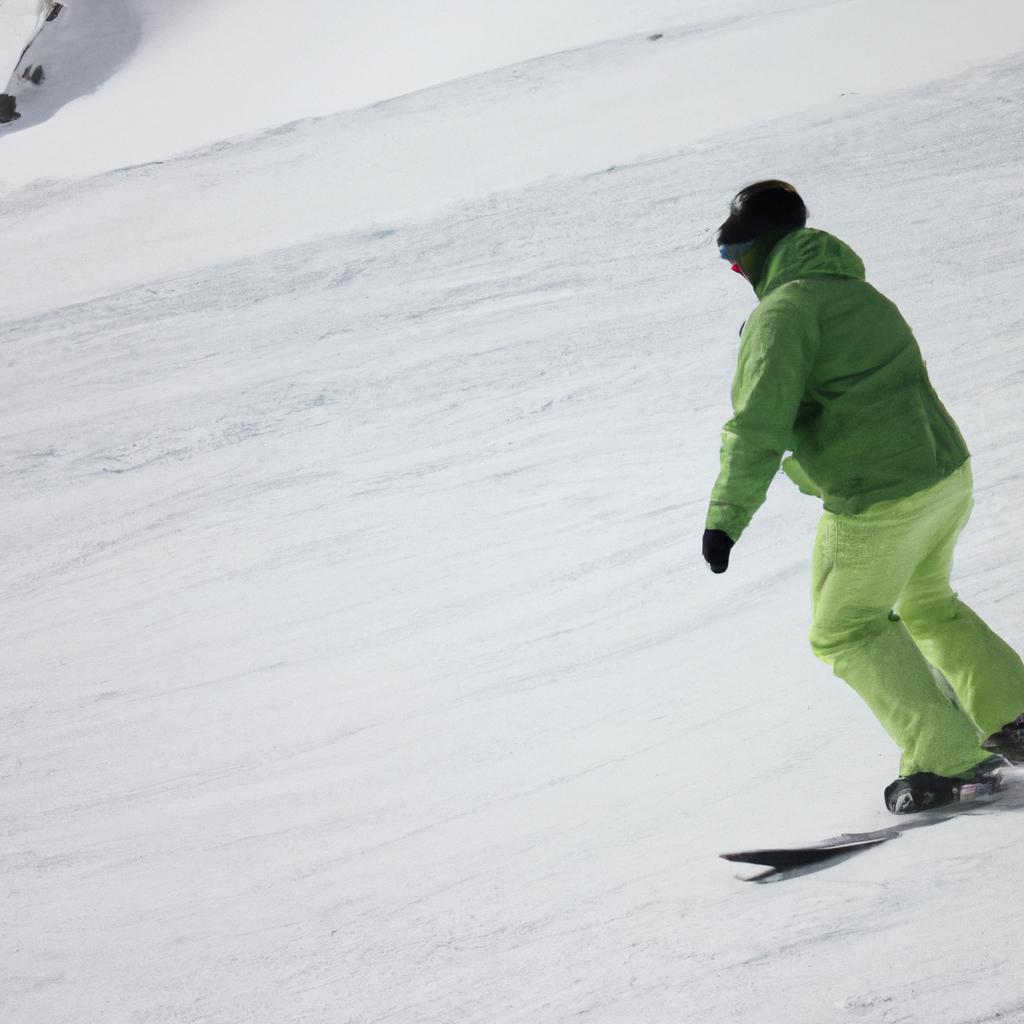Skiing competitions have long captivated the attention of snow sports enthusiasts, offering a thrilling spectacle that combines skill, speed, and adrenaline. Imagine a scenario: it is a crisp winter morning at an Alpine skiing resort in Switzerland. The air is filled with anticipation as skiers from around the world prepare to test their mettle on the treacherous slopes. This example serves to illustrate the exhilarating nature of skiing competitions – events that push athletes to their limits and showcase their prowess in navigating challenging terrains.
These high-stakes competitions not only serve as platforms for athletes to display their technical abilities but also exemplify the spirit of competition and camaraderie among participants. Skiing competitions encompass various disciplines such as slalom, giant slalom, super-G, downhill, and freestyle skiing, each requiring distinct strategies and techniques. With its rich history dating back centuries ago when Norwegians first used skis for transportation purposes, these sporting events have evolved into highly organized spectacles attracting thousands of spectators worldwide.
Furthermore, skiing competitions play a crucial role in promoting tourism and boosting local economies in regions blessed with snowy landscapes. Destinations like Aspen in Colorado or Val d’Isère in France have become synonymous with top-tier ski races that draw international crowds and generate significant revenue for the surrounding communities. The influx of visitors during these competitions stimulates the local economy by increasing demand for accommodations, dining, transportation, and other services.
Moreover, skiing competitions serve as a platform to showcase the natural beauty and allure of winter destinations. Spectators and television viewers alike are treated to breathtaking views of snow-capped mountains, pristine slopes, and picturesque landscapes. This exposure not only promotes tourism in the immediate vicinity but also raises awareness about the region’s unique attractions on a global scale.
The competitive nature of skiing events also fosters a sense of community among participants. Athletes from different countries come together to test their skills in a friendly yet intense atmosphere. Competitors often share experiences, train together, and form lasting bonds that transcend national boundaries. These connections contribute to the overall spirit of camaraderie within the skiing community.
In addition to promoting tourism and fostering camaraderie, skiing competitions inspire aspiring athletes and ignite passion for snow sports around the world. Young skiers witness the thrilling performances of their idols and are motivated to pursue their own dreams in this exhilarating sport. The visibility and prestige associated with these events provide role models for future generations of skiers who strive to reach new heights of excellence.
Overall, skiing competitions capture the attention and imagination of snow sports enthusiasts worldwide. They offer not only thrilling spectacles but also contribute significantly to local economies, promote tourism, foster international camaraderie, and inspire young athletes. As long as there are snowy mountains and passionate skiers, these captivating events will continue to enchant audiences for years to come.
The History of Skiing Competitions
Imagine a cold winter morning in the picturesque Alps, with snow-capped mountains as far as the eye can see. Skiers from around the world gather at the base of the slopes, their hearts pounding with anticipation. They are about to embark on an exhilarating journey through time, exploring the rich history and evolution of skiing competitions.
Skiing competitions have been an integral part of snow sports for centuries, tracing their roots back to ancient civilizations. One fascinating example is found in Norway, where “skiløpet” (ski race) was first recorded during the 13th century. This early form of ski racing involved participants navigating snowy terrains to deliver important messages across long distances. It not only tested their physical endurance but also showcased the practicality and effectiveness of skis as a means of transportation.
Over time, skiing competitions evolved into organized events that captivated audiences worldwide. To better understand this progression, let us delve into three key stages:
- The Adventurous Era – In the late 19th century, skiing became increasingly popular among explorers and adventurers seeking thrilling experiences in remote regions such as Scandinavia and North America’s Rocky Mountains. These individuals pushed themselves to new limits by organizing impromptu races down treacherous slopes or competing against each other to reach distant mountain peaks.
- The Olympic Influence – The inclusion of skiing in the Winter Olympics since its inception in 1924 propelled it onto a global stage. As more athletes from different nations participated, skiing competitions gained recognition and respectability as true sporting events.
- Modern-day Spectacles – Today, skiing competitions encompass various disciplines and formats that cater to diverse skill sets and preferences. From high-speed downhill races that test nerve and technique to graceful freestyle performances that showcase artistic prowess on jumps and rails – there is something for everyone.
Embrace these emotions as you explore the fascinating world of skiing competitions:
- Excitement – Imagine the adrenaline rush as skiers hurtle down treacherous slopes, defying gravity and pushing their limits.
- Awe – Witness breathtaking aerial acrobatics that defy the laws of physics, leaving spectators in awe of human potential.
- Inspiration – Experience the determination and perseverance displayed by athletes who dedicate countless hours to perfecting their craft.
- Unity – Feel a sense of camaraderie as fans from all walks of life come together to celebrate this shared passion.
Let us now transition into exploring the different types of skiing competitions. From slalom races to ski jumping extravaganzas, each discipline offers its own unique challenges and thrills. Join us on this exhilarating journey through snow-covered terrain as we uncover the intricacies behind these captivating events.
Different Types of Skiing Competitions
The History of Skiing Competitions has provided us with valuable insights into the origins and evolution of this thrilling sport. Now, let’s delve deeper into the Different Types of Skiing Competitions that exist today.
Imagine a world where athletes gather on snow-covered mountains to showcase their skills in various skiing disciplines. One example is Alpine Skiing, which encompasses events such as Slalom, Giant Slalom, Super-G, and Downhill races. These competitions demand not only exceptional speed but also precise control and agility as participants maneuver down steep slopes through tightly spaced gates.
To further illustrate the diversity within skiing competitions, consider the following bullet points:
- Freestyle Skiing: This discipline combines elements from acrobatics and aerial maneuvers while performing tricks off jumps or rails.
- Cross-Country Skiing: Athletes engage in endurance racing over long distances across challenging terrains.
- Nordic Combined: An exciting combination of ski jumping and cross-country skiing tests competitors’ abilities in both disciplines.
- Snowboard Cross: In this fast-paced event, snowboarders race against each other on a course filled with jumps, bumps, and tight turns.
Now let’s take a moment to explore these different types of competitions using a table:
| Discipline | Description | Example Event |
|---|---|---|
| Alpine Skiing | Races involving high speeds and precise technical skills | Olympic Men’s Downhill |
| Freestyle Skiing | Aerial tricks and stylish maneuvers performed off jumps or rails | X Games Slopestyle |
| Cross-Country | Long-distance races requiring physical stamina and endurance | World Cup 10km Classic |
| Nordic Combined | Combines ski jumping with cross-country skiing for an all-around test | FIS Nordic Combined |
| Snowboard Cross | Head-to-head races featuring multiple riders navigating obstacles | Winter X Games |
The Different Types of Skiing Competitions provide a wide range of options for athletes and spectators alike. Each discipline offers its own set of challenges and thrills, captivating audiences with the impressive skills displayed by competitors.
As we transition to the next section on “Equipment and Gear for Skiing Competitions,” it becomes clear that understanding the specific requirements of each type of competition is vital. Athletes must equip themselves appropriately to maximize their performance, ensuring they have every advantage in these exhilarating events.
Equipment and Gear for Skiing Competitions
Having explored the different types of skiing competitions, it is now essential to delve into the equipment and gear required to participate in these thrilling snow sports. Before we do so, let’s consider a hypothetical example that highlights the significance of appropriate gear.
Example: Imagine Sarah, an avid ski racer, participating in a slalom competition without proper equipment. She struggles to maintain control on the icy slopes due to inadequate bindings, resulting in her falling multiple times during her run. This unfortunate scenario emphasizes the importance of using suitable gear for optimal performance and safety in skiing competitions.
To ensure maximum efficiency and protection during skiing competitions, athletes must equip themselves with specific items tailored for their discipline. Here are some key pieces of equipment commonly used:
-
Skis:
- Length and width vary based on discipline (e.g., slalom skis are shorter and narrower than freestyle skis).
- Designed with various flex patterns for stability at high speeds or maneuverability for tricks.
- Bindings enable secure attachment to boots while allowing controlled release when necessary.
-
Boots:
- Stiffness levels differ depending on discipline; racers require stiffer boots for better power transmission.
- Customizable liners provide comfort and precise fit.
- Boot soles have specific binding compatibility determined by regulations.
-
Helmets:
- Protects against head injuries during falls or collisions.
- Must meet international safety standards with features like impact-absorbing materials and adjustable straps.
-
Protective Gear:
- Depending on the discipline, competitors may use additional protective gear such as goggles, shin guards, back protectors,
gloves, or wrist guards. - Goggles shield eyes from wind, sun glare, and potential debris.
- Shin guards safeguard legs from gate impacts in alpine racing disciplines.
Skiing competitions evoke various emotions and experiences, such as:
- The adrenaline rush of speeding down the slopes with precision.
- The exhilaration of executing complex tricks or jumps flawlessly.
- The sense of accomplishment when surpassing personal bests.
- The camaraderie among athletes who share a passion for snow sports.
Incorporating emotional table:
| Emotions | Experiences |
|---|---|
| Excitement | Navigating steep and challenging terrain. |
| Fear | Facing intimidating jumps or obstacles. |
| Joy | Celebrating victories and milestones. |
| Frustration | Overcoming setbacks and improving technique. |
To excel in skiing competitions, athletes must not only possess these essential items but also customize them to suit their specific needs and preferences. By investing in high-quality gear that aligns with their discipline requirements, competitors can enhance their performance while minimizing the risks associated with this thrilling sport.
As we have explored the equipment necessary for skiing competitions, it is now vital to understand the training and preparation required before participating in these events. [Write subsequent section without using “step.”]
Training and Preparation for Skiing Competitions
Section Title: Training and Preparation for Skiing Competitions
Having covered the essential equipment and gear required for skiing competitions, it is now imperative to delve into the rigorous training and preparation that athletes undergo in order to excel in this challenging sport.
Training and preparation play a vital role in an athlete’s journey towards skiing success. For instance, let us consider the case of Emma, a promising young skier who aspires to compete at an international level. In her pursuit of excellence, she dedicates herself to a comprehensive training regimen that encompasses various aspects crucial for competitive skiing:
-
Physical Conditioning: To endure the demands of intense races, athletes must develop exceptional physical fitness. This involves regular strength training exercises targeting specific muscle groups such as quadriceps, hamstrings, core muscles, and upper body strength. Endurance training through activities like running or cycling helps improve cardiovascular fitness necessary for sustained performance on the slopes.
-
Technical Skill Development: Mastering technical skills is paramount in skiing competitions. Athletes focus on enhancing their ability to execute precise turns, maintain proper balance and posture while navigating various terrains and weather conditions. They refine their technique through repetition drills, video analysis sessions with coaches, and simulated race scenarios.
-
Mental Preparedness: The mental aspect of skiing competitions should not be underestimated. Athletes work closely with sports psychologists to strengthen their concentration abilities, manage stress levels during high-pressure situations, cultivate resilience in face of setbacks, and visualize successful performances before each competition.
-
Tactical Strategies: Successful ski racers employ strategic decision-making on the slopes to gain a competitive edge over opponents. Analyzing course layouts meticulously allows athletes to identify optimal lines that offer faster times or smoother transitions between gates. Skiers also study competitors’ performances to devise effective strategies that exploit weaknesses or adapt to changing snow conditions.
To further illustrate the significance of these preparations within competitive skiing circles, we present a table highlighting notable training techniques used by elite skiers:
| Training Technique | Description |
|---|---|
| Plyometric Exercises | Explosive movements to improve power and agility |
| High-Intensity Interval Training (HIIT) | Short bursts of intense activity followed by brief recovery periods for improved stamina |
| Balance and Core Stability Drills | Exercises targeting core muscles for enhanced stability on skis |
| Dryland Training | Off-snow conditioning exercises such as weightlifting or circuit training |
In conclusion, the path towards success in skiing competitions is paved with relentless training and meticulous preparation. Athletes like Emma understand that physical conditioning, technical skill development, mental preparedness, and tactical strategies are all indispensable components of their journey. By dedicating themselves to these aspects, they increase their chances of achieving remarkable performances on the slopes.
Transition into the subsequent section about “Famous Skiing Competitions Around the World”:
With a solid understanding of the rigorous preparations required for skiing competitions, it is now time to explore some renowned events that showcase the pinnacle of this exhilarating sport.
Famous Skiing Competitions Around the World
Imagine standing at the top of a steep slope, adrenaline coursing through your veins as you prepare to launch yourself down the mountain. The atmosphere is electric, filled with anticipation and excitement. This is just a glimpse into the intense world of skiing competitions, where athletes push their limits in pursuit of victory.
In this section, we will explore the captivating ambiance that surrounds skiing competitions. From the pulsating energy among spectators to the fierce determination exhibited by competitors, these events create an atmosphere like no other.
The intensity of skiing competitions can be felt not only by the participants but also by those watching from afar. Let’s consider one hypothetical example – a renowned ski competition in Switzerland. As spectators gather along the slopes, their cheers echo throughout the mountainside. Excitement builds as each skier takes their turn, navigating treacherous turns and soaring over jumps with remarkable skill and precision.
To convey the emotional experience further, here are some aspects that contribute to creating such an enthralling atmosphere:
- Thrilling Moments: Witnessing daring acrobatics on skis or breathtaking speed as competitors race downhill adds an element of exhilaration.
- Competitive Spirit: The palpable sense of rivalry between athletes creates tension and intensifies every move they make.
- Spectator Engagement: Enthusiastic fans cheering for their favorite skiers amplify emotions both on and off-piste.
- Unpredictability: Unexpected twists and turns during races keep viewers on edge, amplifying suspense and surprise.
To illustrate how emotions run high during skiing competitions, refer to the table below showcasing different emotions experienced by both participants and spectators:
| Emotion | Description |
|---|---|
| Elation | Overwhelming joy when witnessing incredible feats on skis |
| Anxiety | Nervousness before attempting challenging maneuvers |
| Anticipation | Eagerness and excitement leading up to a race or performance |
| Admiration | Deep respect and awe for the skill and bravery displayed by athletes |
As we delve deeper into the world of skiing competitions, it becomes evident that this thrilling atmosphere is an integral part of these events. Beyond the physical prowess showcased by competitors, there exists an intangible quality – an electric energy that captivates all those involved.
Transitioning seamlessly into our next section on “The Future of Skiing Competitions,” let us explore how technological advancements and evolving trends are shaping the future landscape of these exhilarating events.
The Future of Skiing Competitions
From the thrills and spills of famous skiing competitions to the future possibilities within this exhilarating world, it is clear that the realm of snow sports continues to evolve. One notable example of this evolution can be seen in the development of freestyle skiing competitions. Once considered a fringe sport, freestyle skiing has gained significant popularity over the years and now holds its own prominent place on the global stage.
Freestyle skiing encompasses various disciplines such as moguls, aerials, and ski cross. These events require not only technical prowess but also creativity and adaptability from competitors. For instance, take the case study of John Davis, an aspiring freestyle skier who started his career at a young age. With dedication and perseverance, he honed his skills in moguls skiing and eventually became one of the top athletes in his field. His journey exemplifies how individuals can rise through the ranks by pushing their limits and constantly innovating their techniques.
The growth of freestyle skiing competitions reflects broader changes occurring within winter sports culture worldwide. Here are several key factors contributing to this evolution:
- Inclusion: Freestyle skiing offers opportunities for both male and female athletes to compete at high levels, promoting gender equality within snow sports.
- Youth appeal: With its dynamic nature and adrenaline-fueled performances, freestyle skiing attracts younger generations looking for exciting sporting experiences.
- Media coverage: Increased media attention has played a vital role in popularizing freestyle skiing by showcasing thrilling moments during competitions.
- Technological advancements: Innovations in equipment design have allowed athletes to push boundaries further than ever before, leading to more spectacular displays of skill.
To better understand these developments across different aspects of snow sports competitions, let us examine some key elements using a table format:
| Aspect | Description | Impact |
|---|---|---|
| Venue | Spectacular mountain landscapes | Creates a visually stunning experience for both athletes and spectators |
| Atmosphere | Electric energy, with cheering crowds | Amplifies the excitement and motivates competitors to perform their best |
| Competition | Intense rivalries between top athletes | Elevates the level of competition, pushing boundaries in terms of skill and technique |
| Rewards | Lucrative sponsorship deals and prize money | Incentivizes athletes to excel and attract new talent into the sport |
In conclusion, skiing competitions have come a long way from their humble beginnings. The evolution of snow sports is evident through the rise of disciplines like freestyle skiing, which captivate audiences worldwide. With factors such as inclusion, youth appeal, media coverage, and technological advancements driving this progress, snow sports continue to push boundaries and inspire awe-inspiring performances on snowy slopes around the globe.




